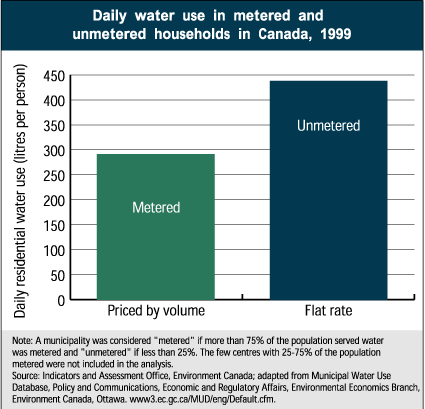

 
|
|
|
|
|
||
   
 Download the
report in Adobe PDF format (4746 KB). Download the
Adobe Acrobat Reader |
What is the issue?Canadians consume higher quantities of water per person than citizens of any other country in the world, except for the United States. Municipal water use strains the capacity of surface reservoirs and groundwater supplies and results in high energy and economic costs for treating and distributing water, as well as for treating wastewater. Even after treatment, the water released may be of poorer quality, which will affect the water downstream from the treatment site. In drought-prone areas, excessive water use decreases water levels and stream flows. In turn, this affects the natural capability of rivers and lakes to deal with pollutants. What do we know?Canada's water supply is generous by any standard, but it is not always plentiful where it is needed most. Ninety percent of Canadians live in a narrow band within 300 kilometres of Canada's southern border, while 60% of the water supply flows north. This concentration of people puts high and competing demands on some local water supplies, affecting the quality of the water and creating moderate to severe seasonal water shortages. Approximately eight million Canadians continue to rely exclusively on groundwater for their daily water needs. Municipalities dependent on groundwater, notably those in Prince Edward Island, southern Ontario, the southern Prairies, and the interior of British Columbia, experience more frequent water shortages than those relying on surface water. In 1999, about 26% of Canadian municipalities with water distribution systems reported problems with water availability within the previous five years.  Overall, daily municipal water use in Canada for all sectors showed a decrease from the high point of 694 litres per capita in 1989 to 628 litres per capita in 1996. Recently, however, per capita water use increased slightly to 638 litres per capita in 1999, and the population being served by municipal water systems is increasing. As a result, total water volume used is going up. There is severe deterioration in the current water and wastewater infrastructure in Canada. The result is less efficient water and wastewater treatment and a large loss of water through leaks in the waterworks, sometimes comprising as much as 30% of municipal water use. The cost of rebuilding the infrastructure to maintain adequate service levels has been estimated at $40–70 billion over the next 10 years. Generally, Canadians who pay for water use much less when their water bills are based on the amount actually used. For example, in 1999, Canadian households paying for water by volume (i.e., metered) used about 288 litres per day. Households paying a flat rate used 433 litres of water a day, 50% more than the metered households. Between 1991 and 1999, the municipal population using water meters increased by just over 4%.  What additional information do we need?More and more demand is being placed on water supplies in southern Canada: demands from the commercial, residential, and industrial sectors; and demands for water for agriculture, power generation, exports, and hydrological diversions. Comprehensive assessments of the impacts of these multiple water uses on the integrity of aquatic ecosystems are required. Temperature changes are already affecting the hydrological cycles of many of our surface water and groundwater bodies (more details are in the Climate change section of this report). By assessing and predicting the potential impacts of climate change, we can get a clearer picture of the effects it might have on the quantity and quality of Canada's freshwater supplies. What are we doing based on the information we have?The use of water meters in certain Canadian municipalities has led to increased water conservation. Some municipalities have initiated leak detection and correction programs to reduce water loss in their existing distribution systems. These programs can recover funds, help prevent water shortages, and defer the need to develop new supply sources. The federal government has provided the funding for a $100 million Green Municipal Investment Fund, a permanent revolving fund to support implementation of environmental projects, and a five-year, $25 million Green Municipal Enabling Fund, providing cost-shared grants for environmental feasibility studies. Both funds are administered by the Federation of Canadian Municipalities and focus on innovative solutions, including the promotion of energy reduction and water conservation in Canadian municipalities. The federal government's "green infrastructure" projects will provide much-needed assistance to repair and add to the municipal water infrastructure. For further information, see the Freshwater quality section. Further informationFor more information on the freshwater use issue, check the following*:
*Note: Information found on some sites is presented only in the language in which it was written. We apologize for any inconvenience. |
|
|
| Help
| Search
| Canada Site |
|
||
|
The Green LaneTM, Environment Canada's World Wide Web site
|
||
|
|
||
|
|
||